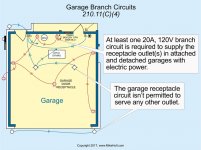trumpetplayertom
Member
- Location
- Fort Lupton, Colorado
- Occupation
- Journeyman Electrician
Was wondering if anyone else is having issues with electrical inspectors on garage receptacle wiring per 2020 NEC? I know that there are multiple states that aren’t on the 2020 cycle but Colorado is, and of course where I reside. Inspectors are using Art. 210.11(C)(4) and 210.52(G)(1) to say that the receptacle in the ceiling for the garage door opener can’t be on the garage receptacle circuit. I have always been able to include that receptacle on the garage circuit. I know that the normal receptacles that serve the garage Bay Area cannot be higher than 5’6. There’s always in most cases a receptacle low enough to serve the bay. Is this accurate or a misinterpretation of the NEC/ Inspector power trip? Ultimately Art. 90 prevails in their case, but they should be accurately interpreting the NEC! Anyone with this issue?

